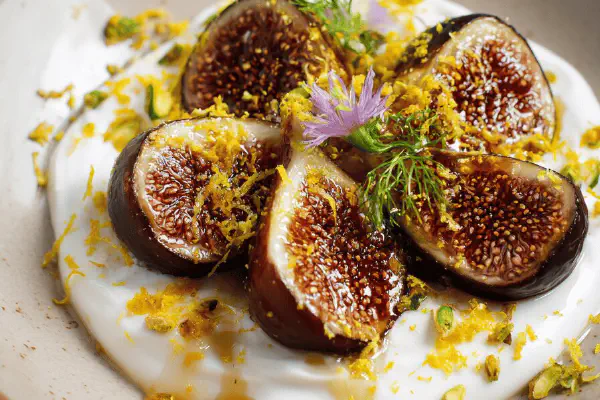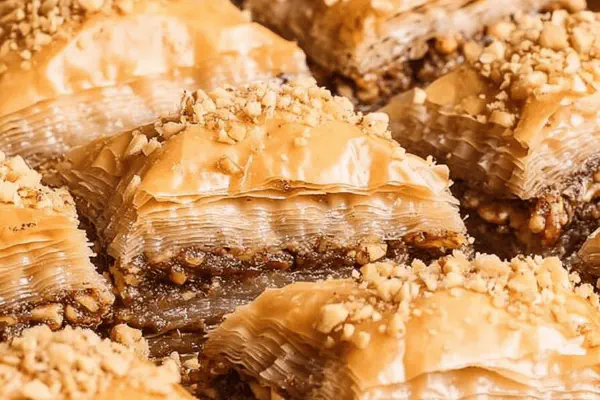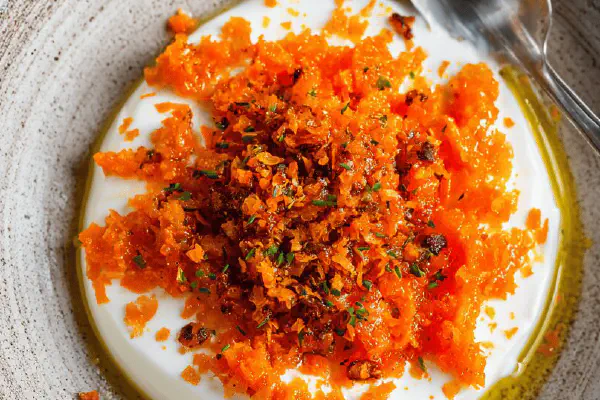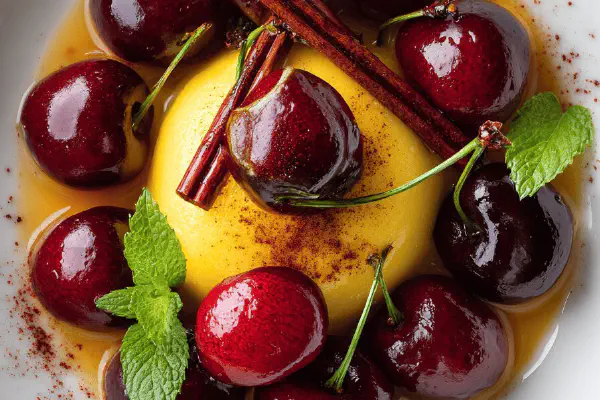Caramelized Figs Honey Yogurt Twist

By Emma
Certified Culinary Professional
Ingredients
- 4 ripe figs, halved
- 25 ml ghee or clarified butter, melted
- 25 ml coconut sugar
- 450 ml thick Greek style yogurt or labneh
- 50 ml wildflower honey
- 1 tsp lemon zest (to infuse honey, optional)
About the ingredients
Method
- 1. Warm a non-stick skillet over medium heat until a drop of water sizzles and evaporates quickly. Toss fig halves in melted ghee, coating fully. Sprinkle coconut sugar evenly on cut sides.
- 2. Lay figs cut side down in skillet. Listen for slow sizzle – sugar caramelizing without burning. Wait until edges bubble with golden amber spots (about 3 to 4 minutes). Avoid stirring or pressing figs.
- 3. Flip figs gently using a thin spatula. Remove from heat immediately. Rest figs in pan 1 to 2 minutes – residual heat softens them further without breaking apart.
- 4. Meanwhile, stir lemon zest into honey if using; let sit. Spoon yogurt onto plates with a rounded scoop. Place figs leaning against yogurt mounds.
- 5. Drizzle honey-laced with citrus over figs and yogurt. Serve immediately. Contrast between warm figs and cool tangy yogurt is key.
Cooking tips
Chef's notes
- 💡 Heat control is key. Medium heat only. Sugar bubbles slow, edges amber not dark. You get that soft crackle sound. Watch closely. Flip figs before sugar burns. Ghee helps browning better than butter; less smoke faster crust. Rest figs off heat 1-2 mins for residual softness. Avoid stirring – skin fragile, sugar crust delicate. Coconut sugar adds subtle molasses, brown sugar works but dulls brightness. Citrus zest infuses honey; muddle zest lightly to release oils. Dairy texture matters; thick Greek yogurt or labneh holds figs without sliding. Warm yogurt slightly if fridge cold shock you don’t want.
- 💡 Cut figs clean with sharp small knife. Bruised figs won’t caramelize evenly; edges go dark, centers stay firm. If your skillet isn’t non-stick, preheat longer, watch sugar bubbles. Burnt sugar ruins flavors no fix; wipe pan clean mid-cook if needed. Don’t crowd pan; figs need space to caramelize edges well. Timing flexible; rely on look and smell – sweet, toasted, not burnt. A pinch flaky sea salt on figs before serving lifts final flavors but do only if honey very light, not overpowering sweetness. Remember sugar caramelizing is faster on edges; keep figs flipped gently to avoid breakage.
- 💡 Honey alternatives? Maple syrup okay but thinner, watch drizzle spread on plates. Agave too runny, shifts viscosity on plating. Yogurt substitutes? Ricotta stands in but less tangy, spoon differently. Butter swap to ghee for sharper crust. Fig softness crucial; underripe stay hard, overripe break. Aim for tender with slight bite. Rest figs in warm pan crucial – residual heat finishes softening without drying. Spoon yogurt with round scoop; prevents spreading, lets figs lean naturally. Prepare plating before figs finish; sugar hardens fast, plate quickly to maintain gloss and texture contrast.
- 💡 Keep heat even; too hot sugar blacks. Listen for slow sizzle, color changes from pale gold to amber edges first. Visual cuing over timers. Caramel forms then stop moving figs, don’t press or stir or skin breaks, sugars spread uneven. If pan sticks, wipe clean, lower heat. Watch jump between bubbling sugar and quiet caramel slick. Use shallow pan for even heat distribution. If serving later, preheat oven low to warm plated dessert; fig sugar crust hardens if cool too long. Lemon zest in honey wakes aroma; lemon essential oils float in syrup. Fold zest before drizzle for brightness without bitterness.
- 💡 Simple ingredient swaps work but change textures; ghee over butter deeper notes. Brown sugar dulls brightness but still caramelizes well. Labneh adds creaminess, richer feel than yogurt; thick Greek style preferred for texture contrast not runny. Freshness of figs non-negotiable. Firm figs won’t soften, overripe mushy. Use sharp knife to cut halves cleanly to avoid bruising. Non-stick skillet preferred; if not, longer preheat, gentle heat. Salt flakes sprinkle at last moment on figs, balance sweet honey if honey very mild, don’t add if honey very floral or strong. Timing and sensory checks trump clocks.
Common questions
How to know when figs are caramelized right?
Listen for soft sizzle, edges bubble amber spots. Look for golden sheen not dark brown. Touch gently with spatula—fig skin holds but softens. Smell buttery nutty-sugar aroma; avoid burnt scent. Timing about 3-4 minutes but heat matters. No stirring; sugar crust fragile.
What if I don’t have ghee or clarified butter?
Use regular butter but watch heat lower, it burns fast. Coconut oil possible but flavor shifts. Ghee preferred for higher smoke point, better crust. Butter needs close heat control, often sift sugar thinner to prevent burning. Adjust time as bubbling changes; slower caramel is safer than fast dark burn.
Can I substitute honey?
Maple syrup works; less sticky though, watch drizzle spreads fast. Agave too runny; changes texture contrast on plate. Citrus zest infusion harder in liquids other than honey. Flavor less floral with syrups. Sweetness level close. Experiment butter swap impacts too. Maybe add more lemon zest if swap honey.
Best way to store leftovers?
Refrigerate figs with yogurt separately. Figs lose crisp sugar crust fast; store on paper towel lined container to absorb moisture. Yogurt tight covered fridge. Reheat figs gently in pan low heat—avoid melting sugar too much. Honey drizzle stored separate or drizzle fresh before serving. Not good make far ahead; sugar hardens, fig texture changes drastically.



